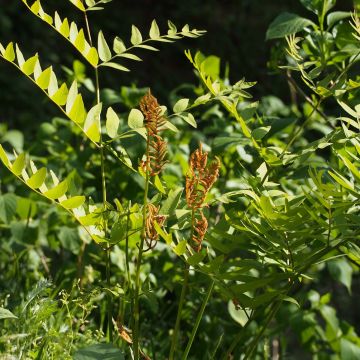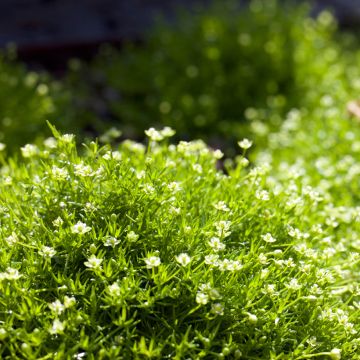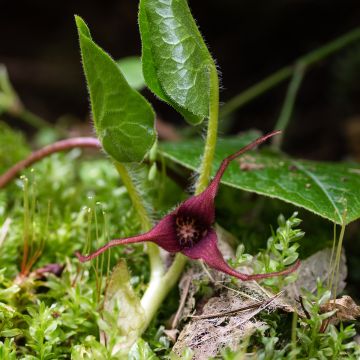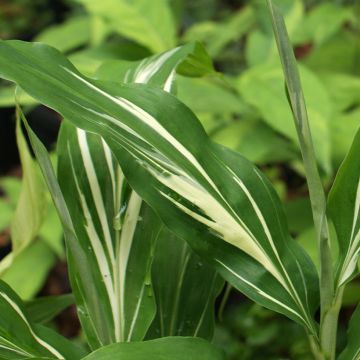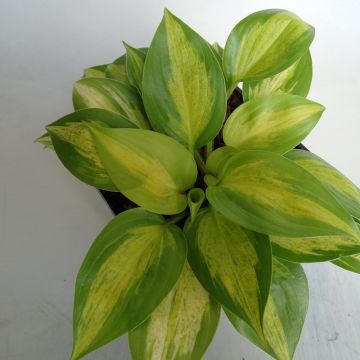

Osmunda regalis Purpurascens - Royal Fern
Osmunda regalis Purpurascens - Royal Fern
Osmunda regalis Purpurascens
Royal Fern, Flowering Fern
This item cannot be shipped to the selected country
Delivery charge from €5.90
Delivery charge from €5.90
More information
Schedule delivery date,
and select date in basket
This plant carries a 12 months recovery warranty
More information
We guarantee the quality of our plants for a full growing cycle, and will replace at our expense any plant that fails to recover under normal climatic and planting conditions.
From €5.90 for pickup delivery and €6.90 for home delivery
Express home delivery from €8.90.
From €5.90 for pickup delivery and €6.90 for home delivery
Express home delivery from €8.90.
Does this plant fit my garden?
Set up your Plantfit profile →
Description
Osmunda regalis 'Purpurascens' is a magnificent fern of large dimensions, with rather slow growth, and elegant fronds tinged with purple, especially the young croziers in spring. This remarkable Purple Royal Fern, to be planted in semi-shade in moist and fertile soil, takes on beautiful golden autumn shades, illuminating the shaded areas of the garden with a splendid blaze!
Osmunda regalis, commonly known as Royal Fern, is a large deciduous fern originating from temperate and subtropical regions and belonging to the family Osmundaceae. It is present in many regions of the world, except in Australia. In temperate zones, it grows in plains, on marshy soils or along rivers or lakes; in the tropics, it is found mainly in mountains. This magnificent Royal Fern is becoming increasingly rare in the wild. The Osmunda regalis 'Purpurascens' is a vigorous variety with a spreading habit and large growth, measuring up to 1.5 metres (5 feet) in diameter. Robust and compact tufts of wide, lanceolate and bipinnate sterile fronds, ranging from 50 to 1.5 metres (16.4in to 5 feet) long, emerge from its voluminous rootstock, turning violet in spring and becoming copper-green with purple veins and petioles when mature. From July to September, large fronds, partly fertile, measuring up to 2 meters (7 feet), emerge and end in plume-like spikes of green sporangia, turning ochre-brown when ripe. In autumn, its fronds take on very pretty golden hues. Planted in shade, the Purple Royal Fern will produce fewer fertile fronds, but its overall size will be larger; on the other hand, when planted in a sunny location, it will be more compact and stocky, but will exhibit numerous fertile fronds. Its growth is rather moderate in the first few years as it takes some time to fully establish itself.
The Royal Fern is dedicated to Saint Christopher, considered the patron saint of travelers. Its roots possess numerous medicinal properties: astringent, diuretic, purgative, and tonic properties... The fibrous, dense, and voluminous rhizome, perfectly suited for the cultivation of epiphytic plants, is used for the production of supports or substrates for the cultivation of certain orchids.
This Purple Royal Fern should be planted in moist and humus-rich, acidic or neutral soil, in full sun or semi-shade. It is therefore ideally placed along the edge of a water feature (pond, stream, marsh, basin, waterfall), but it also thrives in the edge of woodlands or rock gardens, as long as the soil remains consistently moist. Allow enough space around it for it to fully develop. With its very graphic appearance, it fits perfectly in a contemporary garden, a water garden, a wild garden, a shade garden, and even a Japanese garden. It can be grown as a standalone plant, but will also be an excellent companion for plants that have the same requirements as it does, such as Ligularias, Rodgersias, Gunneras, Virginia Sweetspires, Siberian, Japanese or marsh Irises, Marsh Marigold, Spiranthes, Japanese Maples, Trollius, Solomon's Seal, Water Mint, and Blue Himalayan Poppy.
Report an error about the product description
Osmunda regalis Purpurascens - Royal Fern in pictures






Foliage
Plant habit
Botanical data
Osmunda
regalis
Purpurascens
Osmundaceae
Royal Fern, Flowering Fern
Cultivar or hybrid
Other Osmunda
Planting and care
Osmunda regalis 'Purpurascens', being a fern of wet areas, should be planted in partial shade, sheltered from strong winds, in a moist, fertile soil, rich in humus, preferably acidic. It tolerates non-burning sunlight well if the soil remains constantly moist. Planted in less ideal humidity conditions, its proportions will be significantly smaller and regular, abundant watering will be required. Its location should be chosen definitively as it does not like to be moved. Very robust, vigorous, and extremely hardy (up to -25°C (-13°F)), it requires very little maintenance and is suitable for beginner gardeners. Planting can be done in spring or autumn. Dividing the stumps should be done on well-established clumps, either early in spring or in autumn. Choose stumps with distinct rootstocks for guaranteed results. An annual addition of leaf compost in spring will be beneficial. Cleaning the clump should be done in autumn, once its beautiful autumn colours have faded; or at the latest in late winter, before the vegetation restarts. Cut the fronds down to the ground, both the fresh and the dry ones.
Planting period
Intended location
Care
-
, onOrder confirmed
Reply from on Promesse de fleurs
Shade-loving perennials
Haven't found what you were looking for?
Hardiness is the lowest winter temperature a plant can endure without suffering serious damage or even dying. However, hardiness is affected by location (a sheltered area, such as a patio), protection (winter cover) and soil type (hardiness is improved by well-drained soil).

Photo Sharing Terms & Conditions
In order to encourage gardeners to interact and share their experiences, Promesse de fleurs offers various media enabling content to be uploaded onto its Site - in particular via the ‘Photo sharing’ module.
The User agrees to refrain from:
- Posting any content that is illegal, prejudicial, insulting, racist, inciteful to hatred, revisionist, contrary to public decency, that infringes on privacy or on the privacy rights of third parties, in particular the publicity rights of persons and goods, intellectual property rights, or the right to privacy.
- Submitting content on behalf of a third party;
- Impersonate the identity of a third party and/or publish any personal information about a third party;
In general, the User undertakes to refrain from any unethical behaviour.
All Content (in particular text, comments, files, images, photos, videos, creative works, etc.), which may be subject to property or intellectual property rights, image or other private rights, shall remain the property of the User, subject to the limited rights granted by the terms of the licence granted by Promesse de fleurs as stated below. Users are at liberty to publish or not to publish such Content on the Site, notably via the ‘Photo Sharing’ facility, and accept that this Content shall be made public and freely accessible, notably on the Internet.
Users further acknowledge, undertake to have ,and guarantee that they hold all necessary rights and permissions to publish such material on the Site, in particular with regard to the legislation in force pertaining to any privacy, property, intellectual property, image, or contractual rights, or rights of any other nature. By publishing such Content on the Site, Users acknowledge accepting full liability as publishers of the Content within the meaning of the law, and grant Promesse de fleurs, free of charge, an inclusive, worldwide licence for the said Content for the entire duration of its publication, including all reproduction, representation, up/downloading, displaying, performing, transmission, and storage rights.
Users also grant permission for their name to be linked to the Content and accept that this link may not always be made available.
By engaging in posting material, Users consent to their Content becoming automatically accessible on the Internet, in particular on other sites and/or blogs and/or web pages of the Promesse de fleurs site, including in particular social pages and the Promesse de fleurs catalogue.
Users may secure the removal of entrusted content free of charge by issuing a simple request via our contact form.
The flowering period indicated on our website applies to countries and regions located in USDA zone 8 (France, the United Kingdom, Ireland, the Netherlands, etc.)
It will vary according to where you live:
- In zones 9 to 10 (Italy, Spain, Greece, etc.), flowering will occur about 2 to 4 weeks earlier.
- In zones 6 to 7 (Germany, Poland, Slovenia, and lower mountainous regions), flowering will be delayed by 2 to 3 weeks.
- In zone 5 (Central Europe, Scandinavia), blooming will be delayed by 3 to 5 weeks.
In temperate climates, pruning of spring-flowering shrubs (forsythia, spireas, etc.) should be done just after flowering.
Pruning of summer-flowering shrubs (Indian Lilac, Perovskia, etc.) can be done in winter or spring.
In cold regions as well as with frost-sensitive plants, avoid pruning too early when severe frosts may still occur.
The planting period indicated on our website applies to countries and regions located in USDA zone 8 (France, United Kingdom, Ireland, Netherlands).
It will vary according to where you live:
- In Mediterranean zones (Marseille, Madrid, Milan, etc.), autumn and winter are the best planting periods.
- In continental zones (Strasbourg, Munich, Vienna, etc.), delay planting by 2 to 3 weeks in spring and bring it forward by 2 to 4 weeks in autumn.
- In mountainous regions (the Alps, Pyrenees, Carpathians, etc.), it is best to plant in late spring (May-June) or late summer (August-September).
The harvesting period indicated on our website applies to countries and regions in USDA zone 8 (France, England, Ireland, the Netherlands).
In colder areas (Scandinavia, Poland, Austria...) fruit and vegetable harvests are likely to be delayed by 3-4 weeks.
In warmer areas (Italy, Spain, Greece, etc.), harvesting will probably take place earlier, depending on weather conditions.
The sowing periods indicated on our website apply to countries and regions within USDA Zone 8 (France, UK, Ireland, Netherlands).
In colder areas (Scandinavia, Poland, Austria...), delay any outdoor sowing by 3-4 weeks, or sow under glass.
In warmer climes (Italy, Spain, Greece, etc.), bring outdoor sowing forward by a few weeks.



































